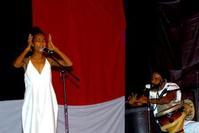Tanya Batson-Savage, Freelance Writer
Ad-Ziko Simba (left) delivers poetry while M'Bala plays the drums at 'Gender Fever 2006'. Simba says Rasta gets token acceptance, then is compartmentalised.
From Bob Marley to the singing Rastaman in the Reggae Sunsplash logo, Rasta and reggae are two of the images most closely linked to the idea of Jamaican culture on the world stage. On the local stage, however, the theatrical one that is, Rasta is in large part missing in action - or, rather, missing from the action.
Though images of Rastafari have cropped up in various productions over the years, almost always they lurk in the periphery, hardly ever being the focus of attention. At other times their presence has been for humour, hardly getting serious attention.
Rastafari's value to Jamaica's cultural identity is probably best seen through the subtle way in which red, gold and green get equal recognition with black, gold and green as Jamaican colours. Dread talk has also woven its way into Jamaican speech, sometimes becoming a part of ordinary Jamaican parlance.
Entertainment fraternity
Poet and talk show host Mutabaruka points out that though the language and symbolism of Rastafari have been co-opted by the populous and the entertainment fraternity, there has been no serious effort to fully understand Rastafarian theology.
"The essence of Rastafari is very hard for
people in the Christian mindset to come to terms with," he said. He noted that in Jamaica Christians remain largely boxed into the colonial and western view of religion, which makes a proper understanding of Rastafari hard to accept.
Yet, the attraction to the outward manifestations of Rastafari remains. "It's all peripheral, really," he said. "They really like the locks and the flashing locks."
Poet, writer and performer Ad-Ziko Simba agrees. She explains that Rasta has been given a token acceptance, but is then "compartmentalised" for use in tourism or promotion and gets no serious interrogation.
"A major reservation I've had over time is that outside of the work of Stafford Ashani the portrayal of Rastafari in theatre - they've been two dimensional characters," director Trevor Nairne of JamBiz International said. "I cannot recall a monumental character.
Interestingly, Nairne directed one of the most recent stagings of Rastafari in Patrick Brown's Ras Noah and the Ark, which prefigured the biblical prophet Noah as a Rastafarian in
modern Jamaica. Though it is an image of a Rastaman as a religious leader, the character is quite two-dimensional and in no way gives a deep understanding of Rastafari.
Arguably, this avoidance of Rastafari on stage may come from a deep-seated conservatism, but Stafford Ashani argues that it comes from an unwillingness to be confronted by the image of a Rastaman as a leader as well as theatre having not dealt with true social realities in Jamaica.
He describes theatre in Jamaica as "just a silly pastime". "Jamaican theatre right now is in an awful state," he said. Ashani argues that though theatre should offer the people a chance at reflection it instead appeals to the lowest denominator. Ashani also argues that an insistent self-hatred also persists and these things are being currently swept under the rug, but serious theatre would insist on dusting out the rug and dusting up everyone in the process.
Ashani argues that there have been times when a role would require a Rastaman, but the character is staged as a "bald-head". He points to Derek Walcott's Dream on Monkey Mountain, and argues that though he has always interpreted that the character is a dread he has always been portrayed without locks.
And so Rastafari still awaits serious exploration in Jamaican theatre and, to an extent, even Jamaican film.

